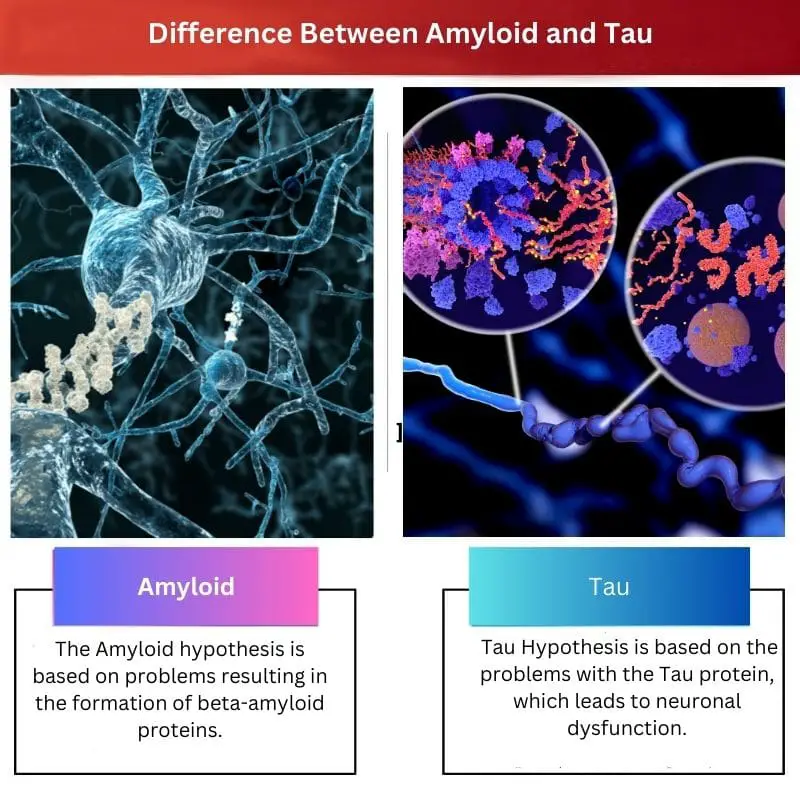Alzheimer’s disease is a progressive neurodegenerative disease. It is one of the leading causes of senile dementia. The underlying mechanism of the disease is still unclear and subject to further scientific research but two of the most popular hypotheses in understanding Alzheimer’s disease are The Amyloid and The Tau hypothesis.
Key Takeaways
- Amyloid refers to protein deposits that form plaques in the brain, while tau proteins form neurofibrillary tangles inside brain cells.
- Both amyloid and tau are associated with Alzheimer’s disease, but they have different roles in its progression.
- Current treatments for Alzheimer’s disease target amyloid, but recent research suggests that targeting tau may be more effective in slowing cognitive decline.

Amyloid vs Tau
Both amyloid and tau are abnormal protein deposits found in the brain in Alzheimer’s disease. These are insoluble proteins and are made up of compact fibres. Amyloid is deposited outside the brain cells, while tau is found inside the neuronal cells. Amyloid forms plaques, while tau forms tangles.
Comparison Table
| Parameters of Comparison | Amyloid | Tau |
|---|---|---|
| Protein Type | Beta-amyloid protein | Tau Protein |
| Region of the Brain Affected | Brain cell connections | Electrical and chemical signals of brain cells |
| Symptoms | Memory loss | Memory loss, Behavioral changes |
| Causing factor | Replacement of alpha-secretase activity with beta-secretase. | Hyperphosphorylation of Tau protein |
| Hallmark Features | Amyloid Plaques | Neurofibrillary tangles |
What is Amyloid?
The Amyloid hypothesis is one of the more researched hypotheses in trying to find treatments to cure Alzheimer’s disease. Normally, the amyloid precursor protein is cleaved by the activity of alpha-secretase and gamma-secretase, producing harmless soluble peptides.
However, mutations in genes encoding amyloid precursor protein and presenilin, which is a component of gamma-secretase, have been associated with an increased propensity for the formation of longer amyloid fragments that aggregate together to form fibrils and oligomers.
These fibrils and oligomers are neurotoxic and therefore, responsible for neuronal death. These oligomers also set off a cascade of events that further destroys the neuronal cells. One pathway is kinase activation which causes the eventual hyperphosphorylation of Tau protein and results in further neuronal destruction.
The Amyloid hypothesis is further strengthened by its association with the early onset of Alzheimer’s disease in people having Down Syndrome. As the Amyloid Precursor Protein gene is located on chromosome 21, the extra copy of the 21st chromosome in people with Down Syndrome proved that any problems with the chromosome number or its mutation were a strong causal factor for Alzheimer’s Disease.

What is Tau?
The Tau hypothesis, on the other hand, is fairly recently researched as the primary cause of Alzheimer’s disease after the trials to combat the formation of beta-amyloid proteins did not yield promising results.
Furthermore, neurofibrillary tangles due to aggregation of tau proteins can be seen in patients with mild dementia but having no beta-amyloid pathology. Moreover, Amyloid plaques can be seen in people without neurodegenerative defects however, the same cannot be said about those having neurofibrillary tangles, as the Tau protein pathology closely correlates with the severity and progression of Alzheimer’s disease.
The Tau hypothesis further argues that the Tau pathology precedes any beta-amyloid pathology and is the primary cause of Alzheimer’s Disease. The Tau protein is responsible for the stability of microtubules, which maintains the transportation of nutrients inside neuronal cells and the integrity of the general cell structure.
Alteration to the Tau protein by undergoing hyperphosphorylation results in Tau protein aggregations into tangles, disrupting the microtubules and disrupting the nutrient supply and cell structure, resulting in neuronal death. These tangles can further travel via the axons and disrupt other neuronal cells, resulting in a functional loss of parts of the nervous system, causing Alzheimer’s Disease.
The clinical trials targeting Tau proteins have not yet shown desirable results however, the hypothesis is fairly recently studied, so not enough clinical data is available as of yet.
Main Differences Between Amyloid and Tau
- The Amyloid hypothesis is based on problems resulting in the formation of beta-amyloid proteins, which is seen as a trigger point in the cascade of events that lead to Alzheimer’s Disease, whereas The Tau Hypothesis is based on the problems with the Tau protein, which leads to neuronal dysfunction.
- The Amyloid hypothesis was based on its strong association with problems with chromosome 21, as any mutation or an extra copy of the chromosome would lead to the early development of Alzheimer’s Disease, whereas The Tau hypothesis suggests a strong connection of neurofibrillary tangles with the severity and progression of the disease.
- For long moments in time, the Amyloid hypothesis was seen as the primary cause which would trigger the events causing Alzheimer’s disease and therefore has been researched longer compared to the Tau hypothesis, which only recently was viewed as a primary cause and not a subsequent result of the Amyloid hypothesis.
- The beta-amyloid pathology has been attributed to causing dementia in patients; however the Tau pathology, in addition to dementia, has also shown its effects on behavioural changes in patients suffering from Alzheimer’s Disease.
- The beta-amyloid fibrils are seen extracellularly in the form of plaques which deposit in different areas of the brain whereas the tau tangles are present intracellularly in the form of neurofibrillary tangles.




